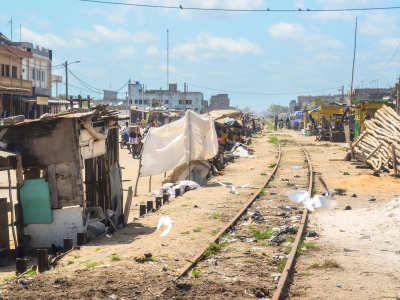
Financing infrastructure development: Quality over quantity
Finance is not the main constraint, despite the current focus on financing infrastructure development in recent summits and discussions around the new sustainable development goals (SDGs), I discuss in this blog.
Rather it is the effectiveness of finance and viable infrastructure projects to invest in. ‘Closing Africa’s infrastructure financing gap will not only involve raising additional funds but also improving the efficiency with which existing resources are used’, the World Bank states.
Poor African Infrastructure Status Puts Development at Stake
Africa’s infrastructure lags behind requirements, and the financial funding gap cannot be underestimated: only 38% of the African population has electricity access, less than 10% internet penetration rate, only 25% of Africa’s roads are paved, and poor port facilities add 30-40% to intra-African trading costs deteriorating the inflow of FDI. This results in expensive infrastructure services, constrained industrial productivity, limited participation in global trade and limited production competitiveness. There is therefore a risk that poor infrastructure facilities undermine the recently improved economic growth performances across Africa. Clearly then there is a need for increased financial means to modernise existing and develop new infrastructure.
Infrastructure – A Real Heavy Weight
Infrastructure is key in several different development debates. On promoting structural transformation, post-2015 development goals, maximising the benefits from extractives and promoting food security, as the following events demonstrate:
- This week’s 23rd African Union Summit, which took place in Malabo, Equatorial Guinea, under the theme of ‘Agriculture and Food Security’ must recognise infrastructure as an important factor for food supply and trade of agricultural products.
- Last week’s “Financing Summit for Africa’s infrastructure” in Senegal, in which participants agreed on The Dakar Agenda for Action (DAA) and ‘re-emphasised the paramount need for the growth impact to be geared towards social inclusiveness and competitiveness through infrastructure modernisation’.
- Current negotiations around the post-2015 agenda, its financing and infrastructure as a fundamental ‘enabler’ of economic transformation – also dealt with in this year’s European report on Development (ERD), ‘Financing and other means of implementation in the post-2015 context’, written jointly by ODI, ECDPM, DIE, University of Athens and the Southern Voice Network. The ERD will be published at the end of 2014 just before the European Year of Development 2015 kicks off.
- Recent discoveries of oil, gas and minerals in the EAC that strengthen the renewed focus on infrastructure to best harness natural resources for development. (An upcoming ECDPM paper dealing with financing regional infrastructure in Southern Africa will discuss this in due course).
Infrastructure is vital for supply, and regional food value chains. Roads, ports and railways are key to developing and exploiting linkages between economic transformation, natural resources and agriculture. The aim is to achieve inclusive growth, to foster intra-African trade and continued regional integration. The current favourable economic landscape is opportune to address the infrastructure deficit by financing both national and regional priority projects by means of the increasing ability and need to mobilise domestic resources and attract more private finance.
Beyond Finance
But it is not all about finance. Neither is it all about the mobilisation of new resources. Rather addressing the infrastructure gaps requires a combination of a conducive enabling environment, effective institutions and actors (public and private), and yes, also sufficient financial means.
Three Foundations for Sustainable Infrastructure Development
Quality matters most, so it may be helpful to think about this in terms of three pillars:
- Enabling environment - Infrastructure development requires an appropriate legal, policy and regulatory environment facilitating efficient capital market development based on legal and fiscal stability. Supporting policies need to ensure investment returns as well as greater transparency in procurement and tendering processes. Simultaneously, harmonisation of regulatory frameworks is key to minimise geographical disparities since infrastructure projects are often of a regional nature (first and foremost, road and rail) and often involve several countries.
- Effective institutions and actors – Strong, capable institutions are critical for the creation of an enabling environment and the implementation of infrastructure projects. Capacity-development is key to ensure project bankability, efficient project preparation and the conduct of feasibility studies. Shared responsibilities between public and private actors need to be understood to achieve transformation and an integrated and interconnected continent based on adequate infrastructure facilities. Particularly, political commitment and will to implement priority and high-impact infrastructure projects jointly with the private sector are decisive for success and financial viability. Increased efforts of public-private partnerships, mutual learning and private sector engagement are therefore needed to align incentives and interests along those projects and goals.
- Financial means beyond aid - There is no doubt that African countries want to use African resources to finance their own development, as reiterated in the DAA: “promotion of African-owned private equity funds, deepening of infrastructure bonds, the utilisation of diaspora bonds and regional stock exchanges, securitisation of remittances and strengthening the existing Sovereign-backed Pension Funds for development projects”. Projects, such as the Programme for Infrastructure Development in Africa 2012-2040 (PIDA) and AfDB’s Africa50 $600 million Infrastructure Fund are good initiatives to address the infrastructure-funding gap if they can overcome the first two challenges.
The Way Forward
Even if you get all of the above right and finance is available, an enabling environment in place and strong institutions present – political commitment ultimately depends on political incentives to prioritise a certain type of investment or project over another.
What are these incentives? What are the incentives to strengthen institutions? And given Africa’s priorities, getting sufficient political momentum and effective institutional mechanisms at the regional level to finance cross-border infrastructures remains a major challenge.
This should really be the focus within discussions around financing the new SDGs, since success of the post-2015 development agenda will ultimately depend on political incentives to successfully finance and implement (infrastructure) projects and/or strategies.
The views expressed here are those of the author, and may not necessarily represent those of ECDPM.

